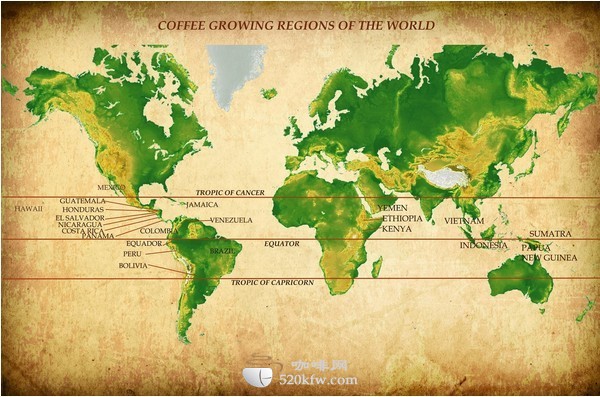Introduction of major producing countries and their famous coffee bean producing areas
Latin America (Central and South America)
Brazil: Santos (Santos), Bahia (Bahia), Cerrado (Hirado), Mogiana (Mojiana)
Mexico: Coatepec, Huatusco, Orizaba, Maragogype, Tapanchula, Huixtla, Pluma Coixtepec, Liquidambar MS
Panama: Boquet, Bolkambaru Coffee (Cafe Volcan Baru)
Peru: Chaximayo (Chanchamayo), Cusco (Cuzco or Cusco), Norte (Puno)
Dominican Republic: Baraona (Barahona)
El Salvador: Pipil, Pacamara
Puerto Rico: Yauco Selecto, Greater La Reis Yuco (Grand Lares Yauco)
Colombia: Armenia Supremo, Narino, Medellin
Guatemala: Antigua (Antigua), Vivette Nanguo (Huehuetenango)
Costa Rica: multi-Tower (Dota), Indy (Indio), Tarazhu (Tarrazu), Sanhe District (Tres Rios)
Cuba: Cubita Tujino (Turquino)
Jamaica: blue Mountains (Blue Mountain)
Ecuador: Galapagos (Gala á pagos), Gigante
Venezuela: Montebello (Montebello), Miramar (Miramar), Granija (Graneza), Ala Granija (Alaganeza)
Nicaragua: West Notega (Jinotega), New Segovia (Nuevo Segovia)
Africa
Democratic Republic of the Congo: Kivu, Ituri
Rwanda: no machine (Kivu)
Kenya: AA, Kenya, Kenya AA Oreti Estate, Kenya,
Uganda: Elgon, Bugisu, Ruwensori
Zambia: Kasama (Kassama), Nakonde (Naconde), Isoka (Isoka)
Tanzania: Kilimanjaro (Kilimanjaro)
Cameroon: Bamileke and Bamoun
Burundi: Ngozi (Ngozi)
Angola: Ambriz, Amborm, Novo Redondo
Zimbabwe: Chipinge
Mozambique: Manyika (Manica)
Ethiopia: Yirgacheffe, Harrar, Djimmah, Sidamo, Lekempti
Middle East and South Asia
Yemen: Mocha Sanani, Mattari
India: Malabar, Karnataka, Tellichery
Vietnam: weasel coffee (Weasel Coffee)
Indonesia: Java (Java), Mantenin (Mandheling), Ankora (Ankola), civet coffee (Kopi Luwak)
East Asia and Pacific Islands
Mainland: Yunnan Coffee, Hainan Coffee
Taiwan: Guo Coffee (the most widely cultivated township in Taiwan according to the statistics of the Agriculture and Food Department in 2010), Gukeng Coffee, Zhongpu Coffee, Dongshan Coffee, Dawushan Coffee, Alishan Coffee (Zou Coffee), Mizuho Coffee (Hualien), Jiufen Ershan Coffee, Chiayi Ruili Huojinju Coffee
Hawaii: Kona
East Timor: Maubbessee

Important Notice :
前街咖啡 FrontStreet Coffee has moved to new addredd:
FrontStreet Coffee Address: 315,Donghua East Road,GuangZhou
Tel:020 38364473
- Prev

The main ingredients of coffee basic knowledge of fine coffee
1. Caffeine has a particularly bitter taste and stimulates the central nervous system, heart and respiratory system. Appropriate amount of caffeine can also reduce muscle fatigue and promote digestive juice secretion. Because it promotes kidney function, it is diuretic and helps the body to expel excess sodium ions from the body. But eating too much can lead to caffeine poisoning. two。 After the tannic acid is boiled, the tannic acid will be decomposed into pyrouric acid.
- Next

Three meanings of Mocha basic knowledge of Fine Coffee
1) Coffee mocha: Cafe Mocha means chocolate coffee, made of Espresso, milk, chocolate sauce and light cream. 2) Moka Pot: invented by Italian Bialetti, it is a simple and convenient choice for cooking Espresso at home. 3) mocha beans: the port of Moka in Yemen was once the largest coffee trading port. Although it has dried up, it is still used to using coffee beans from nearby areas.
Related
- Beginners will see the "Coffee pull flower" guide!
- What is the difference between ice blog purified milk and ordinary milk coffee?
- Why is the Philippines the largest producer of crops in Liberia?
- For coffee extraction, should the fine powder be retained?
- How does extracted espresso fill pressed powder? How much strength does it take to press the powder?
- How to make jasmine cold extract coffee? Is the jasmine + latte good?
- Will this little toy really make the coffee taste better? How does Lily Drip affect coffee extraction?
- Will the action of slapping the filter cup also affect coffee extraction?
- What's the difference between powder-to-water ratio and powder-to-liquid ratio?
- What is the Ethiopian local species? What does it have to do with Heirloom native species?

